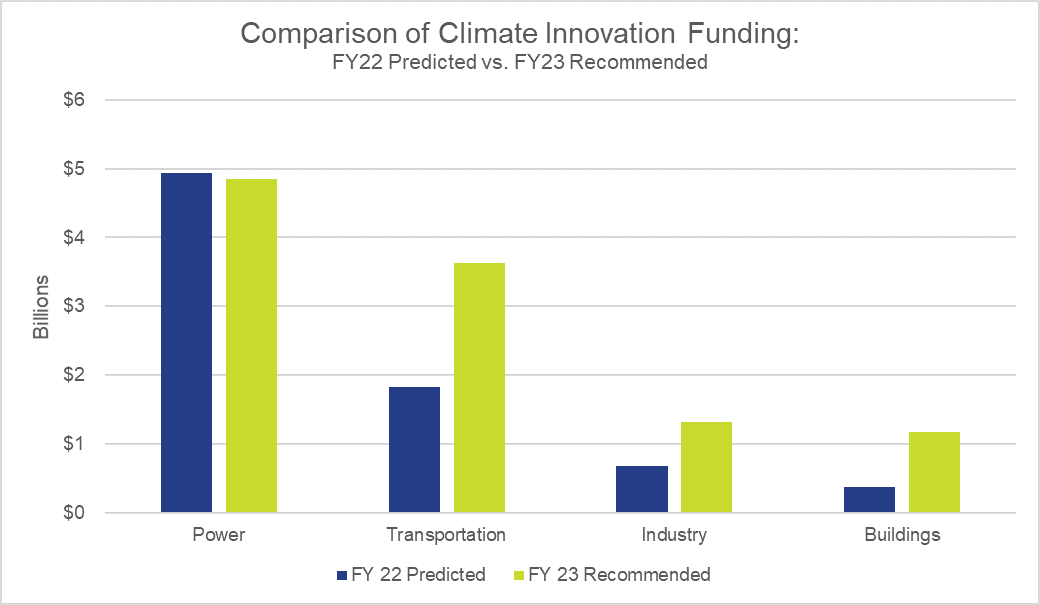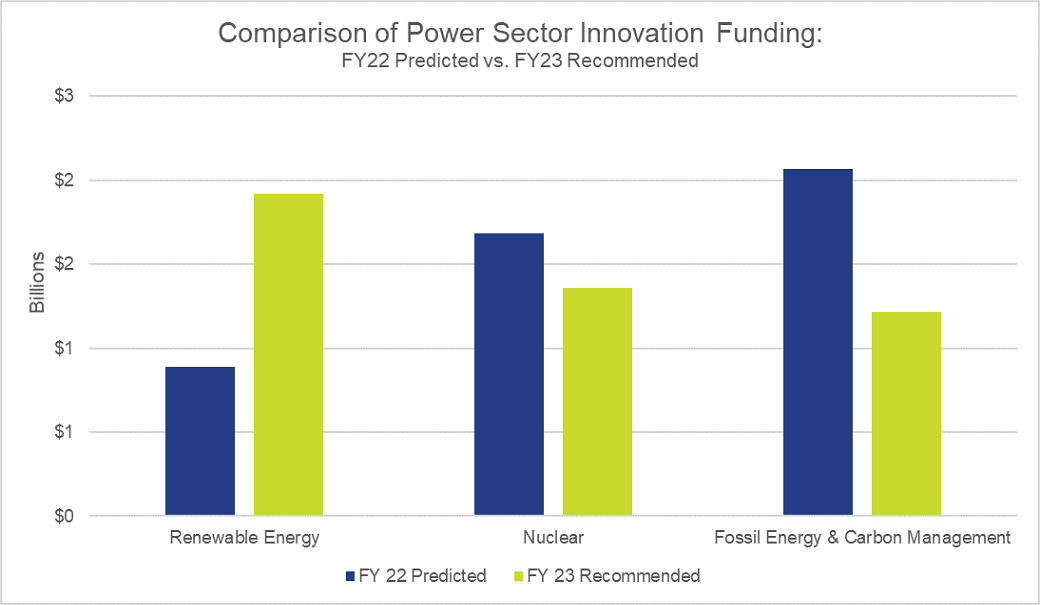This blog was co-authored by Danielle Arostegui, Manager, U.S. Climate at EDF.
2021 saw major momentum for U.S. climate innovation: the research, development and scaling up of new solutions needed to tackle climate pollution, create jobs across the U.S. and reduce energy costs. President Biden reiterated his pledge to deliver a $400 billion investment in climate innovation over 10 years. The Department of Energy, led by Secretary Jennifer Granholm, began creating and reorienting key innovation programs toward taking on the climate challenge. And Congress passed the bipartisan Infrastructure Investment and Jobs Act (IIJA), which makes significant investments in emerging solutions like energy storage, carbon dioxide removal, clean hydrogen and more, all of which may play a role in helping us achieve net-zero emissions by 2050.
This momentum is buoyed by strong voter support for climate innovation across parties: A recent Morning Consult poll found that nearly three-quarters of adults support U.S. investment in climate innovation, including majorities of Democrats, Republicans and Independents. Meanwhile, we’re seeing a continued push in the Senate for the largest-ever climate bill, the Build Back Better Act, which would make historic investments in clean power, clean transportation and environmental justice, along with some targeted innovation funding.
The takeaway? This past year has created a significant and much-needed step forward in advancing climate innovation, which makes now a good time to take stock of the progress we’ve made and areas where we still have work to do to meet the climate test.
A roadmap for meeting the climate test in innovation
What does it mean to meet “the climate test” in innovation? It means investing now in authentic solutions that lead to significant and measurable pollution reductions to achieve net-zero emissions by 2050 and maintain a livable planet for future generations. The Climate Innovation Blueprint, which we released last year, provides a framework for determining whether or not we are on track to meet this test. By drawing on energy modeling that covers a range of climate technologies, the report outlines how federal policymakers can best leverage limited climate innovation funding to maximize climate benefits.
Our first recommendation to policymakers is to grow the clean energy research, development and demonstration (RD&D) budget at DOE to $32 billion by FY 2025, including nearly $17 billion in the applied energy programs, which would put us on track to meet President Biden’s pledge to achieve $400 billion in funding over the next 10 years.
Ramping up this investment is key because the amount of money the U.S. has spent on energy RD&D as a percentage of GDP has declined by 75% since the 1970s, even as the growing threat from climate change has made it more important than ever that we invest more, not less, on energy innovation.
But meeting the climate test is not just about increasing the overall budget, it’s also about rebalancing that funding in alignment with the biggest challenges ahead by:
- Focusing on the major sources of climate pollution, including sectors that are currently under-funded, such as industry, buildings and agriculture; and within those sectors, prioritizing the solutions with the greatest potential to generate major climate benefits.
- Supporting the entire innovation process, not just early stage R&D, but all the way through demonstration projects that test cutting-edge solutions at real-world scale and commercialization programs that can accelerate their adoption in the market. Our report recommends dedicating $10 billion per year for commercial-scale demonstration projects alone.
- Creating cross-cutting programs that coordinate across offices and end-uses because we know that breakthroughs in some climate technologies – like batteries, which have multiple applications in different sectors – will not happen in a silo.
Taking stock of climate innovation investments
To assess U.S. progress toward meeting the climate test, we totaled up expected innovation funding for 2022 to get an upper bound estimate of the Fiscal Year 2022 (FY22) innovation budget.
Comparing this predicted FY22 budget with our recommendation for FY23, based on our Climate Blueprint, allows us to identify where we are on track and where there are funding gaps, even under optimistic assumptions for this year’s funding. [Learn more about how we calculated these budgets here.]
Here are the takeaways:
1. Overall federal innovation funding appears on track to meet the climate test.
Federal funding for clean energy RD&D is poised to increase this year, bringing it in line with our recommendations for FY22. This is largely thanks to the IIJA, which will inject over $20 billion into building commercial-scale clean energy demonstration projects over the next five years and establish a brand new Office of Clean Energy Demonstrations in DOE to house this new cross-cutting initiative. In addition, Congressional budgeters appear likely to modestly grow climate innovation funding in other areas.
This is great news and worthy of celebration, but our work is not done yet. In order to stay on track with U.S. climate targets, the federal innovation budget will need to continue to grow in the ballpark of $10 billion next year.
2. We are making good progress on establishing and growing critical cross-cutting programs.
The new Office of Clean Energy Demonstrations (OCED) not only reflects a major uptick in resources, it also addresses a longstanding gap in the innovation pipeline: piloting technologies beyond the lab and out in communities. This new office will help prove the effectiveness of a wide range of climate technologies – including direct air carbon capture, grid-scale energy storage, clean hydrogen, small modular reactors and more.
And this is not the only sign of progress toward better coordination across impactful energy technologies and solutions:
- Congress appears likely to include increased funding for the cross-cutting Advanced Research Projects Agency-Energy (ARPA-E), dedicated to advancing high-potential, high-impact energy technologies that are too early for private-sector investment. Together with OCED, this represents a big step toward supporting historically underappreciated – yet essential – stages of the innovation process that pave the way for widespread adoption and deployment.
- DOE also made a splash earlier this year when it announced the Office of Fossil Energy would officially change its title to include “Carbon Management” – reflecting the Office’s increased focus on meeting U.S. climate goals and reducing carbon emissions. Carbon management strategies, including carbon capture, sequestration and utilization, will likely be important for curbing carbon pollution from hard-to-transition industries and drawing down pollution from the atmosphere.
3. Key sectors contributing to climate pollution still need more funding.
Looking ahead to next year, transportation, industry and buildings need to see more innovation investment to fully leverage their potential in the climate fight. The figure below shows the gap between this year’s expected budget and our recommendations for FY23.
Figure 1

Sector-by-sector comparison of climate innovation funding for DOE based on what’s predicted in FY 2022 and what EDF recommends in FY23.
Transportation is both the largest source of climate pollution in the U.S. and a major contributor to health-harming air pollution. Addressing these dual challenges will require roughly doubling investment in this sector in the next fiscal year to support a range of cutting-edge, clean transportation solutions. Industry, which currently contributes 23% of U.S. emissions, will also be an increasingly critical sector for climate innovation in the coming years and will require a growing budget to develop and test new pollution-cutting solutions for this hard-to-decarbonize sector. Meeting the climate test will also require that we step up investment in climate solutions for buildings.
4. The power sector is on track overall, but renewable energy is relatively underfunded.
The power sector has historically received the lion’s share of climate innovation resources, and that trend continues to this day. But the power sector’s high funding obscures an imbalance in the relative distribution of funding among power-generating technologies.
Figure 2

Comparison of climate innovation funding for DOE’s power sector programs based on what’s predicted in FY 2022 and what EDF recommends in FY23. The FECM office received significant funding from the IIJA, putting it ahead of the curve on the recommended inputs in the Climate Blueprint Report. However, annual appropriations continue to be below recommended levels, pointing to the need to continue to strengthen support for carbon management into the future.
Comparing the relative funding levels of renewables, nuclear, and fossil-related energy technologies, as we have done in Figure 2 above, shows that renewable energy is being significantly underfunded in comparison to other technologies, as well as in comparison to our recommendations. While the cost of solar and wind has fallen substantially over the past decade, thanks in large part to U.S. investment in innovation, we shouldn’t stop there. Continued innovation in renewables will be important for making these technologies even more reliable, efficient and affordable as they play a larger role in powering our grid.
In the last year, new funding has given climate innovation a big boost on a number of fronts, particularly in advancing demonstration projects to prove emerging solutions. But to best position us to achieve our ambitious 2030 goals and get to net-zero emissions by 2050, we should aim to balance the U.S. climate innovation portfolio towards investments that deliver the biggest carbon bang for our buck.
While understanding the innovation funding gaps is critical, we cannot lose sight of the fact that the Build Back Better Act is by far our biggest opportunity to unlock immediate progress on cutting pollution – incentivizing the build out of cost-effective, clean energy, zero-emissions trucks, buses, cars and more right now. BBBA is the priority for laying the foundation for a cleaner, more equitable economy and driving progress toward our national goal to cut emissions by 50-52% below 2005 levels by 2030. The promise of breakthrough technologies in the future is no substitute for the urgent task of cutting as much pollution as we can right now with existing technologies.
2021 was a very good year for climate innovation. With a potential path forward for Build Back Better in the Senate, and additional opportunities to supercharge innovation to a scale needed to meet the climate challenge, we can make 2022 an even bigger year.
